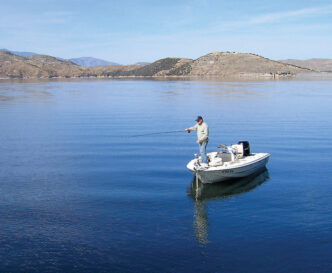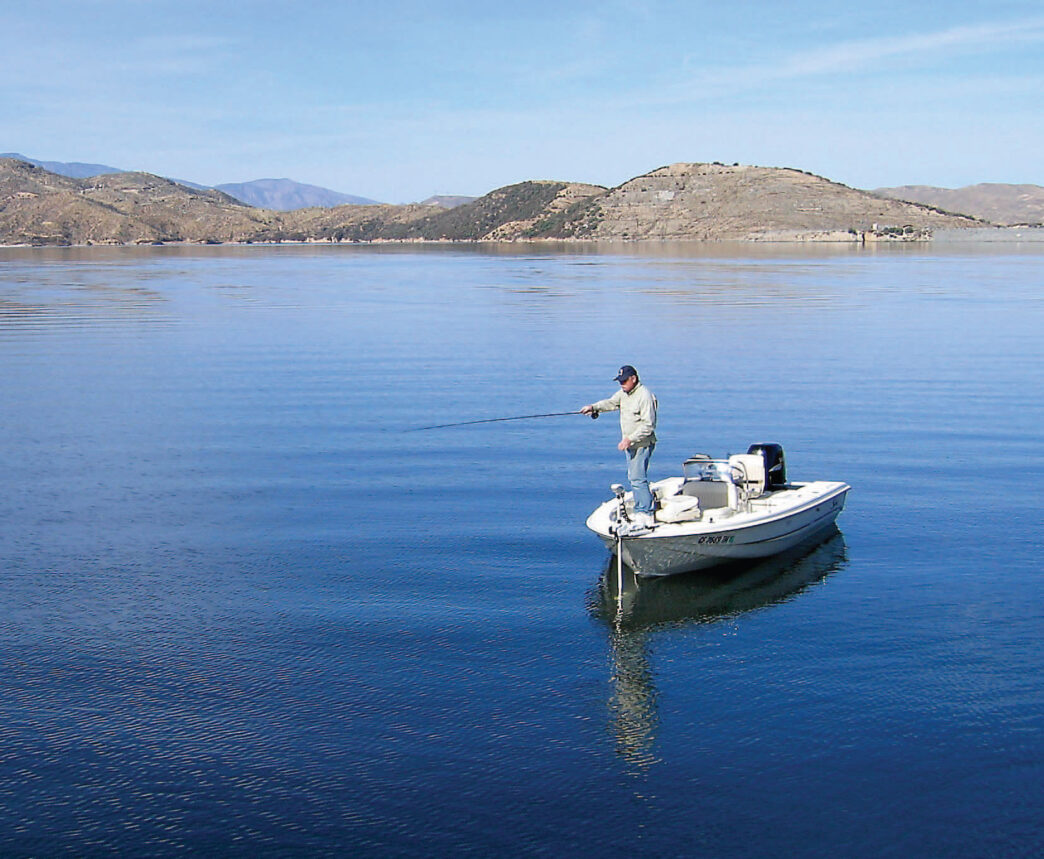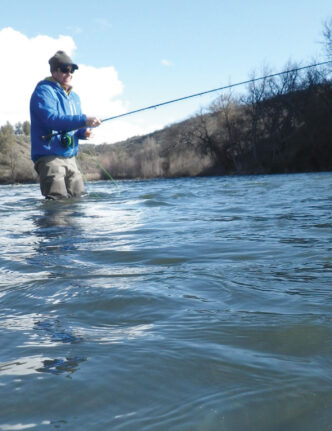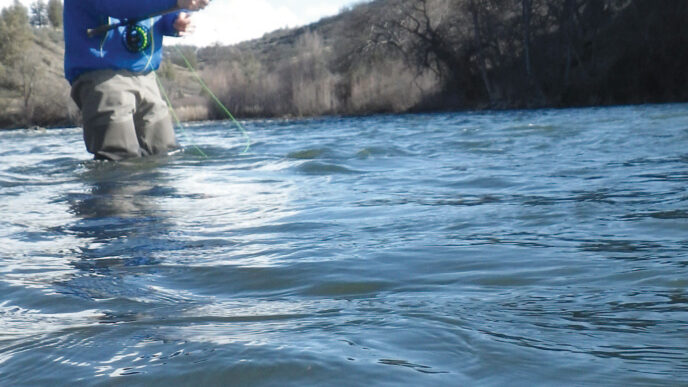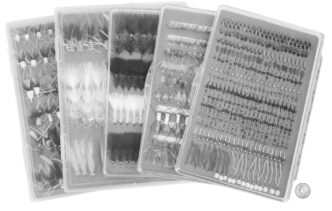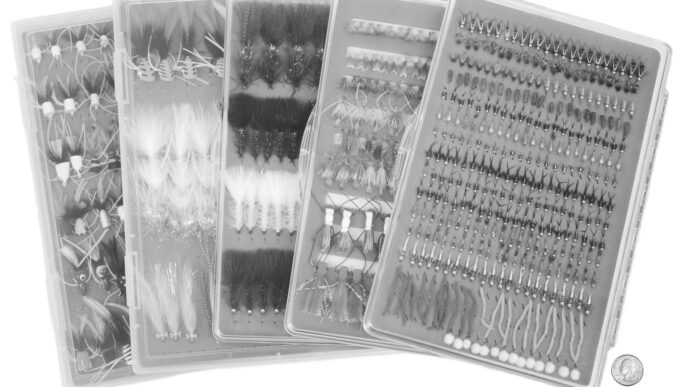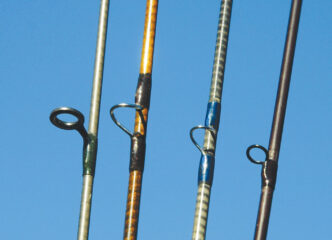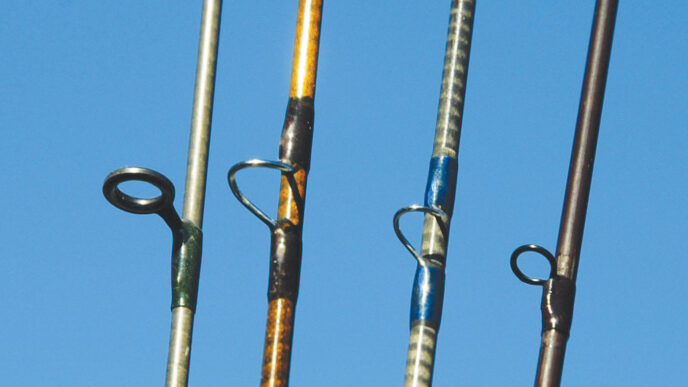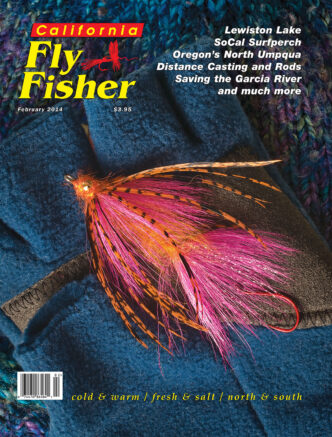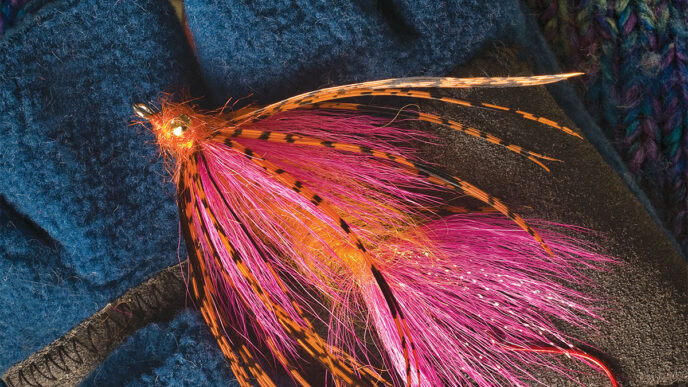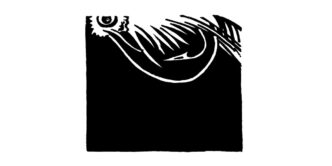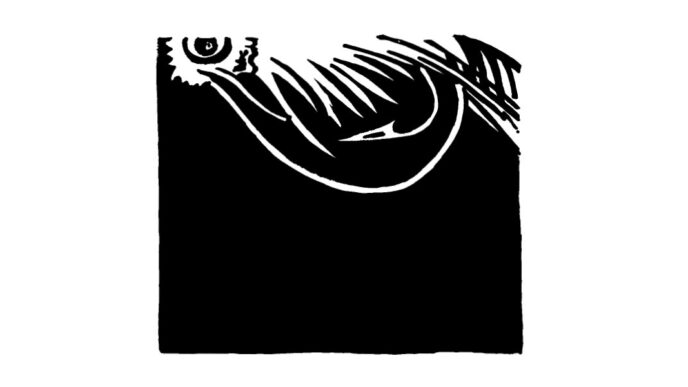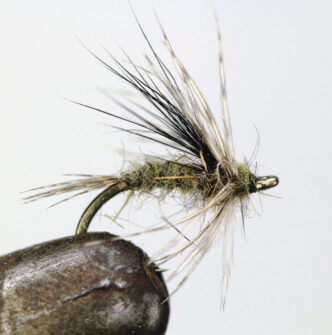A while back, I was hauling a friend’s boat out of the water at a local impoundment when the guy next to me said in a loud voice, “This damn lake doesn’t have any fish in it.” To my surprise, there was a rumble that spread along the dock that indicated almost everybody there agreed with the guy. That it had been a slow day was evident. It was far less evident that all the fish in the lake had somehow disappeared. The impoundment receives rainbow trout from both Department of Fish and Wildlife and a local hatchery, and it also has striped bass and all the expected warmwater species.
In the hook-and-bullet magazine stories of another era, this would be the point where the author becomes a local hero by lifting up a whole stringer of fish. But that was then. I borrowed my friend’s smart phone and walked over to the guy who had been complaining. I showed him pictures of three big trout and two even bigger stripers that we had taken on flies that morning.
The guy looked at the images of the fish, then examined our rods, reels, and fly lines. He didn’t say much, and after he walked away to attend to his own boat, he didn’t look back. When I didn’t say anything for several minutes, my friend finally laughed and remarked, “Another guy who couldn’t find the structure, huh?”
I thought about this for a long minute and finally replied, “Well, hell, we searched all over this lake for a month before you found the first spot that would hold a trout of a decent size.” He nodded a reply, and we got into his pickup and left the lake.
Structure in Winter Lakes
Broadly speaking, there are two types of lakes that anglers fish during winter. Both are found at moderate to lower elevations. The first type of winter lake is the flood-control reservoir, which was created to store precipitation so that folks who work or live in the flood plain of a river don’t get washed away. Flood control as it is practiced here usually means letting out water at a moderate rate all year (thus these reservoirs also supply water for municipal and agricultural uses), so by the time winter arrives, the reservoir is drained far enough to hold the expected runoff that collects during the coming spring. Such lakes often have pretty good fishing in the spring and through most of the summer, but by the time winter arrives, they may not have enough water to cover shoreline structure. If the lake, for example, has good weed beds in
the spring, those weeds will be out of the water and well up on the bank by late fall. At low pool, these lakes can seem to be devoid of fish-holding structure, although because they are usually created on top of a river, you do have the drowned channel to explore, as well as a defined inlet that might draw fish.
The other type of low-elevation lake is one that is usually part of a water-transport system such as the various reservoirs on the California Aqueduct. Water flows through them more or less constantly from the north to the south. These reservoirs are best treated simply as wide spots in the aqueduct, and aqueducts are not exactly noted for the variety of fish-holding bottom structure that they provide.
In both cases, the bottom of the impoundment can be as barren as the bottom of a soup bowl. So what do you do when you fish a basin that has little in the way of structure?
A Worst-Case Scenario
There are not many waters that don’t have at least a few bumps or objects submerged in them to offer a hiding spot for fish, despite the California engineering practice of shaving the bottom of reservoirs and aqueducts almost completely bare. Probably the most barren angling venue in the state offers a worst-case scenario: the Salton Sea.
For the first 45 years of its life, the Salton Sea was nothing more than California’s largest puddle. It did not exist until a 1905 flood damaged an irrigation dam and canal near Yuma. This allowed a torrent of water from the Colorado River to run unchecked into the dry valley for two years, forming a shallow lake some 20 miles wide by 45 miles long. Evaporation reduced the original lake, and it’s now 35 miles in length, and, depending on water flows, some 15 miles across. At one time it was home to a number of big, moody saltwater predators and lots of bait — a nice combination.
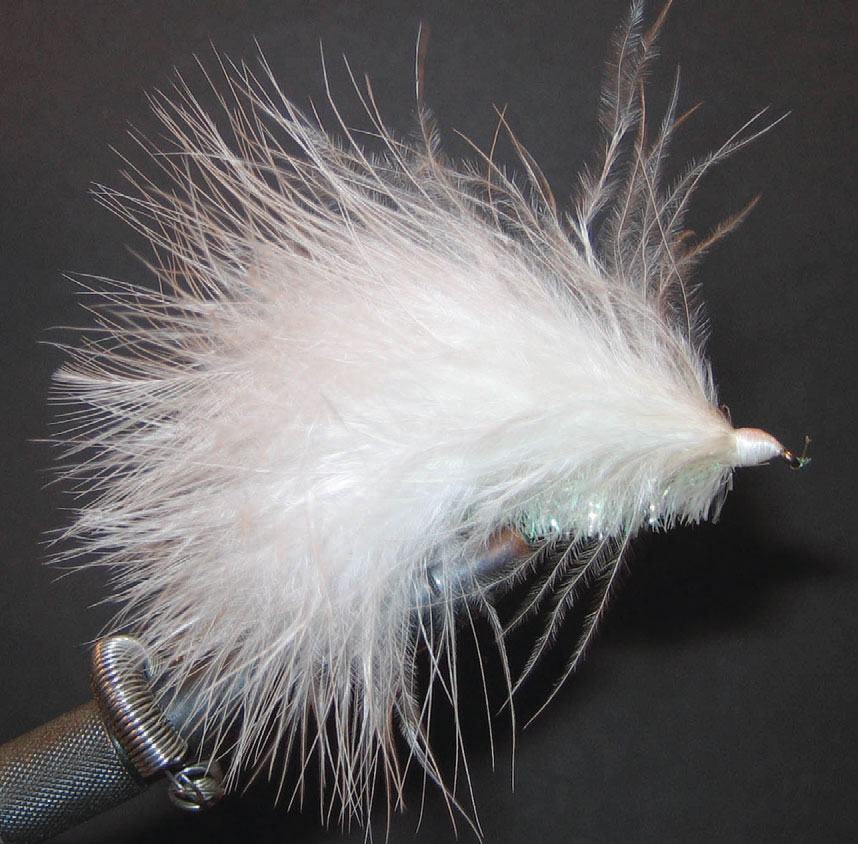
As the name suggests, the water in the Salton Sea is saline. Very saline. In the early 1950s, the California Department of Fish and Game decided to stock it with fish that would tolerate the high salinity. They initially planted everything from striped bass to salmon, but the increasing salinity kept those fish from surviving, They next tried a small number of orangemouth corvinas, sargos, and croakers from the Gulf of California. These fish established a viable fishery. Tilapias, an oversize African cichlid, were stocked in the irrigation canals that feed the sea, and they created another fishery as they moved into it. At some point, a few fly-rod anglers tumbled to the fact the corvinas had grown to record size, and the race to catch the biggest corvina in the Salton Sea kicked into high gear.
Most of the Salton Sea was just plain flat — and shallow. The Colorado River water covered what used to be nothing more than flat desert. There wasn’t a whole lot of structure when the water rose up, and there wasn’t much there during the heyday of corvina fishing, either. For the most part, you just chucked a fly as far as you could and hoped.
I distinctly remember deciding to grapple for a bit of structure we’d located, where we’d taken several good fish. Twenty minutes of arm-wrenching tosses with a anchor and rope produced the bottom half of some desert traveler’s trunk. It wasn’t much, but it was the only thing a powerful corvina could possibly hide behind in 20 miles of flat lake bottom.
Tech Talk
Finding structure like that — finding any structure at all, in fact — required a high-quality depth finder. If you just motor around a drawn-down impoundment, the way those guys we encountered at the dock had done, you’re stuck with the chuck-and-luck approach that many ended up using on the Salton Sea. To find structure on the bottom of a soup bowl, you need some high-tech help.
Depth-finding sonar that reveals both structure and holding fish is one obvious way to go, but the hardest bit of bottom structure to locate is not an old soup can sitting on a mud bottom. No, the hardest thing to locate is a submerged freshwater spring. These things will normally attract and hold a bunch of fish — especially trout, if the lake has them. Unless these fish show up on the depth finder, you will need a temperature probe to locate a spring. Even then, unless you can get a temperature probe right into the discharge from a spring, you’ll never find it.
There is another way to locate structure, however small, though — visually, believe it or not. It ain’t easy, and it ain’t cheap, but you can use one of those small video cameras in a waterproof housing to scan the bottom for places that hold fish.
I’ve applied variations of all these methods to locate fish-holding structure and fish in the bowls of flood-control and aqueduct reservoirs. Here are a couple of examples.
Lake Elsinore
Roughly rectangular, running from northwest to southeast, Lake Elsinore is shaped like a molar, with two “nerves” running away from the main body of the lake on the southeast end. This impoundment is part of the California Aqueduct system, and it doesn’t have a lot of structure. Probably the best description of this large, shallow, low-altitude lake (1,200 feet above sea level) came from John Hendrickson, a guide in San Diego. “Lake Elsinore is like a flooded football field,” he said.
Elsinore is indeed shaped a lot like a football stadium, only without any bleacher seats to provide cover along the sides. Brush grows along the lake in the spring and into the summer, but it isn’t backed up by much primary structure in the lake itself for big predators to gravitate to when waters turn cold. Primary structures are big stuff. For instance, a long, rocky point running out into the middle of a reservoir is primary structure. The rock pile that pushes up to within a few feet of the surface halfway out on the primary structure is secondary structure. About the only real primary structure you find in Lake Elsinore are half a dozen large pumping towers spaced at regular intervals along the lake bottom. These do have fish on them at times, but even they do not offer big fish a deepwater home.
At Elsinore, you need a high-quality depth-finder in order to locate and mark structure of any size within the body of the impoundment. Some sizable fish roam the lake, and it can be a surprising fishery — one that is getting better. Slow trolling with a sinking line and a whitish fly that mimics a threadfin shad is the way to go, once you find fish. Consider also checking out the marina. According to Hendrickson, “One of the areas of the lake that does have some structure is the west corner of the lake where the Lake Elsinore marina is located. The marina was excavated to provide a boat channel, and structure was created there.”
Lake Perris
Lake Perris, in Riverside County is also a typical bowl-bottom lake. It has greatlooking shorelines — or it used to, before the water agency dropped the lake level 27 feet to offer some extra protection to people who live in Perris’s flood plain. There have been a lot of changes around Perris since it was built.
The engineers who shaped Lake Perris put artificial structures into it before the water went in. There’s a reef made of old tires, and some nicely crafted rock structures in various spots. Out in front of Alessandro Island, however, all the way to the dam, there is a huge hunk of empty water with what looks like an empty bottom. But is it really that way?
One morning, many years ago. I met with three other bass anglers. One of the guys had invested his cash in a small submersible TV camera, and we were going to use it on Lake Perris’s big blank spot to see what was there.
It worked all right. It also revealed the problems you’ll have using the camera to hunt small, isolated bits of structure. We tried sweeping with the camera the way you would with a depth finder. We had to go over an area several times before we got even a glimpse of whatever was there to see. We did find some surprising bits of stuff — secondary structure. I remember locating a discarded one-gallon can with several feet of rope tied to the handle — somebody’s makeshift anchor, probably. It was the only bit of anything that stuck up more than six inches within a 20-yard circle. To our surprise, it was occupied by one of the largest crappies I’d ever seen.
The “owner” of this particular property must have easily weighed three pounds. This was before anybody knew there were crappies in Lake Perris. I suspect the reason this fish had not been caught was that its chosen bit of cover was well away from any other structure, in the big blank spot on the Lake Perris topo map that might as well be marked “Here there be dragons.”
While the camera gave us good closeups of this and other fish at home in their small lairs, it proved to be a detection system you wouldn’t want to use all day long. The field of view was too small. Overall, we had much better luck fishing the “bald spot” using a decent depth finder. The newer, side-looking models performed quite well.
The System Approach
Over time, I’ve developed a system for fishing drawn-down impoundments where there is little fish-holding bottom structure. As at Elsinore, this involves what is basically a trolling rig.
The first element in the system is a stout fly rod coupled with a high-capacity reel. To this is added a full-sinking fly line. I have a fast-sinking double-taper line backed with a lot of running line and headed up with a straight leader of monofilament, about 6-pound to 8-pound test.
You’ll want to troll a fly that mimics a small baitfish. A white fly with a bit of blue or black on the back seems to work best. For several seasons, I primarily use the B/S Fly, a white marabou streamer that is easy to troll and to cast and that the big predators like to eat.
Lately, I’ve added the Coyote to my list of flies. The Coyote is an offshoot of the Clouser Minnow that has been fitted with a tiny Colorado spinner blade under the nose of the fly. It works better in low light or stained-water conditions. Clouser Minnows in shad colors and any other white streamer fly you choose will work, too. (Shad are a common forage fish in Southern California’s reservoirs.)
Although this is primarily a trolling rig, it doesn’t cast all that badly if you happen to find structure that is holding fish and you think you can throw a fly there. Keep in mind, however, that many isolated structures will be small, most will only hold one fish, and the deeper they are situated, the more difficult they will be to accurately target.
If this approach to scraping the bottom of a bowl sounds simple . . . well, it is. The main features are a rod/reel/line setup that will get you to the bottom of the bowl and an excellent depth finder and temperature probe that will tell you what is on the bottom. This is not a particularly exciting way to angle, but it will help you find where the fish are and where the small bits of structure well away from the shore are located. And, most importantly, it will allow you to catch fish when other less resourceful anglers strike out.



